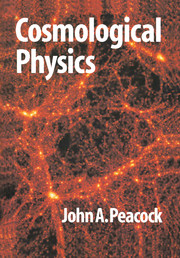Book contents
- Frontmatter
- Contents
- Preface
- Part 1 Gravitation and relativity
- Part 2 Classical cosmology
- Part 3 Basics of quantum fields
- 6 Quantum mechanics and relativity
- 7 Quantum field theory
- 8 The standard model and beyond
- Part 4 The early universe
- Part 5 Observational cosmology
- Part 6 Galaxy formation and clustering
- Hints for solution of the problems
- Bibliography and references
- Useful numbers and formulae
- Index
8 - The standard model and beyond
Published online by Cambridge University Press: 05 June 2012
- Frontmatter
- Contents
- Preface
- Part 1 Gravitation and relativity
- Part 2 Classical cosmology
- Part 3 Basics of quantum fields
- 6 Quantum mechanics and relativity
- 7 Quantum field theory
- 8 The standard model and beyond
- Part 4 The early universe
- Part 5 Observational cosmology
- Part 6 Galaxy formation and clustering
- Hints for solution of the problems
- Bibliography and references
- Useful numbers and formulae
- Index
Summary
Elementary particles and fields
The apparatus of quantum field theory is an effective tool for calculating the rates of physical processes. All that is needed is a Lagrangian, and then there is a relatively standard procedure to follow. The trouble with this generality is that there is no way of understanding why certain Lagrangians are found in nature while others are not. The present chapter is concerned with the progress that has been made in solving this problem. The last four decades have seen tremendous developments in understanding: a few simple principles end up specifying much of the way in which elementary particles interact, and point the way to a potential unification of the fundamental interactions. These developments have led to the standard model of particle physics, which in principle allows any observable quantity related to the interactions of particles to be calculated in a consistent way.
The standard model asserts that the building blocks of physics are a certain set of fundamental particles from which the composite particles seen in experiments are constructed; their properties are listed in table 8.1 (see the references to the Particle Data Group in the bibliography). This set is much larger than the electron, proton and photon, which were all that was needed in 1920, but it is believed to be complete.
- Type
- Chapter
- Information
- Cosmological Physics , pp. 215 - 270Publisher: Cambridge University PressPrint publication year: 1998



